
Henry Salisbury and his family moved into a cottage near Yew Tree farm
West side
Crossing the lower end of the Common one came to the cottages near Yew Tree Farm [now known as 15 Leyton Road, Prezzos]. In the nearby cottages lived David Dimock. ‘Dave’ as he was known, was a journeyman butcher. He was much in demand when local people had a pig to kill. Many people kept a pig in their back yard to help supplement their supply of food. Dave, a burly genial character, took with him his equipment when called upon to slaughter the family pig. This consisted of a scalding tub, pig rack and steel yard – this was necessary as everyone wanted to know the weight of the porker, if only to talk about it later. Dave was quite used to having a choice cut of pork for his trouble, instead of money.
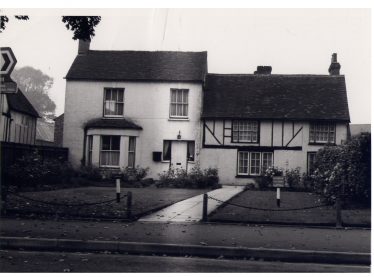
Yew Tree Farm – currently Prezzo restaurant
At Yew Tree Farm lived another Henry Wilmott (see Henry Wilmott who lived nearly opposite at Home Farm). Henry is described as a corn dealer. In later years when the farm was sold it was described as having a coach house, loose box and harness room, poultry house and cornstore, also a cow house and yard. This site occupied the land right up to the corner of Amenbury Lane.
Leyton Green
And now we come to Leyton Green. Here lived Henry Gifkins, Registrar of Births, Deaths and Marriages. He lived in the tall house on the Green [with an interesting later history] and was head of the office staff at Rothamsted. He was a short man of cheerful and joking disposition. He was well educated and wrote in a beautiful copperplate hand as can be seen from the census forms. He was one of the Enumerators for the [1871] census. At one time he had kept a small private school at this home. He had a large family, and one with a very wide age range. Of his four daughters, the youngest were 12 and 16, while the two elder were 35 and 45 years of age.
Their father must have been married twice. He also had five sons, one of whom acted as an enumerator as well. George Gifkins was Clerk to the Parish Church, leading responses on Sundays, and saying the alternate verses of the psalms. He did not approve when chanting of the psalms was introduced. He continued to work until a great age, sometimes falling asleep over his work. Eventually one of his daughters took over from him as Registrar for the Parishes of Harpenden, Redbourn, Sandridge and Wheathampstead.
Quite close by lived William Gifkins, a brother. Both had been born in Berkhamsted. William was a gardener: he planted the lime avenue in Rothamsted Park.
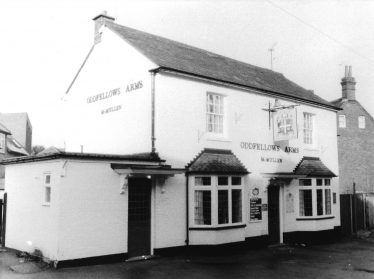
The Oddfellows Arms
A beer house, The Oddfellows [The Oak Tree], was kept by Amos Borders. In the cottages around the Green lived several families, including George Sygrove, a brewer’s labourer and Henry Hawkins who was a sawyer. The Hawkins family had two boarders – a gardener aged 82 and a bonnet sewer. They also had a lodger, who was a carpenter. Many families in the village had a boarder or lodger.
Also on Leyton Green lived William Lowin, a member of the Wesleyan Chapel. He was a tall, handsome man, and worked on the experimental plots at Rothamsted. He was known as ‘Father Lowin’ and was often teased by his workmates for his faith. His foreman is reputed to have said that one day he heard a voice behind a hedge during the dinner break, and realised it was Lowin in prayer – he said “I knew then that the man was a saint”. William’s wife is recorded as a washer-woman. She was ten years older than her husband who was 47.
Anscombes in Leyton Road
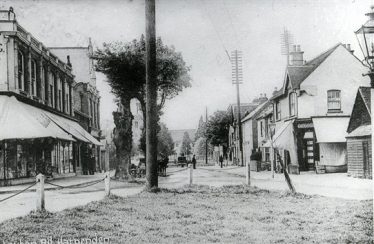
Anscombes and the view along Leyton Road towards Church Green – 1890s
Alan Anscombe is described in the census as being a draper and grocer. He had a large household: with his wife, one daughter and four sons lived three male and one female assistants in his business. There was also one apprentice, one servant and a visitor, who was a student of Theology. Note is made that Mr Anscombe employed twelve assistants at the time of the census.
Gardener to the Rector, Canon Vaughan, was George Rodwell. He had moved to Harpenden when his employer became Rector. He laid out the gardens at the new Rectory that had been built along the Luton Road. George Rodwell lived in one of the cottages that became known as Batchelors Row: these were demolished to make way for Macfisheries Supermarket [currently M&S Food]. He was verger and organ blower at the Parish Church, and also assisted Mr Gifkins. His son became a teacher at the British School.
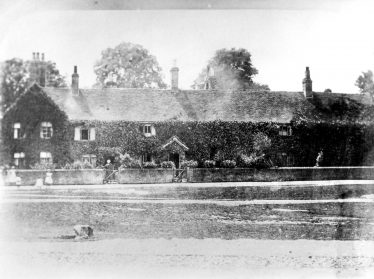
Batchelors’ Row, Church Green
A neighbour was Helen Brash, a widow. She had come from Scotland, and kept a small general shop. Earlier she had been described as a tea dealer. Mrs Brash is recorded as selling particularly good toffee. No doubt the children of the recently opened National School were among her customers, if they were fortunate enough to have any money to spend on sweets. The name board of Mrs Brash’s shop was found under the ivy over her cottage when it was pulled down in 1959.
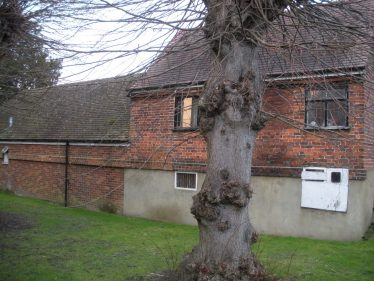
Remains of cottages facing the churchyard – former Widows’ houses
Henry Leedham lived in the old workhouse. Here he carried out his trade as a rope maker. His son, another Henry, was his assistant. He made ropes for the bells of the Parish Church, for use in wells and for farmers. There were times when he had to extend his work to stretch across the High Street itself.
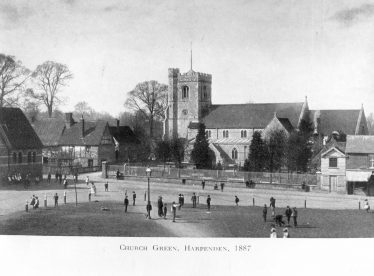
Church Green – with cottages by the church; the National School on the left
By the gate leading into the Churchyard lived George Hawkins, He was sexton and a sawyer by trade. He is recorded in the Parish Magazine at the time of his death in 1886 as having been of remarkable strength, and of having an excellent memory – it was said that he could relate the history of those lying in the churchyard. His father had been sexton before him, and he had lived in the same cottage all his life. The duties of a sexton included digging graves and keeping the churchyard neat and tidy.
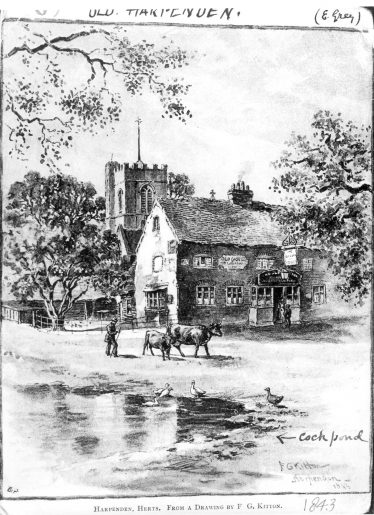
Geese on the Cock Pond?
A near neighbour was ‘Joey’ Russell. He was a simple, quiet batchelor, recorded in the census as an errand man. ‘Joey’ owned a few geese which he took to the Cock pond each day. It is said that as he watched over them he plaited straw. This was reputed to be plait of very good quality. He wore an old and battered ‘billycock’ hat and a faded smock. When Sunday came he wore a more respectable smock of a brighter green, and left his plaiting at home.
Church Green in the 1890sIn the cottages around the Green, where the fair was still held each September, lived other men of the labouring classes. A Master Butcher, William Steabben, lived on the North side of the green at this time; later he had a shop which stood at the corner of Rothamsted Avenue and Leyton Road. His neighbour was a Master Draper, Owen Sexton. He was supported in his business by his wife who was a milliner.
Turning back into the High Street, the Cock Inn was kept by Joseph Trustram, who was also a builder and an undertaker. Mr Trustram also kept a set of threshing ‘tackle’ which required six horses to move the engine and its equipment from farm to farm.
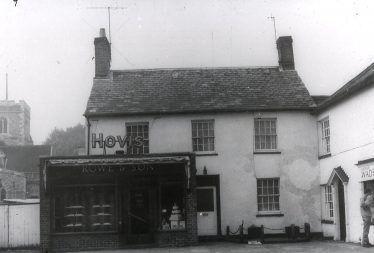
The baker at 58 – later Rowes
John Irons, a Master Baker, lived and had his baker’s shop where there was a baker [Rowes] until recent years. In the cottages next door lived a builder, William Robinson; John Marten a boot and shoe maker; and Henry Lines, who was a blacksmith. His forge was on the opposite side of the road.
These three cottages formed part of what later became the public house, known as the Old Red Lion. The Red Lion was occupied in 1871 by William Townsend, an unemployed engineer. There is no suggestion that he was also a beer seller at that time.
This was the last building in the village centre, until one came to the new Rectory, a little past Townsend Lane. There was an old tithe barn in Church Wick field, opposite the Sun Lane turning.
The ‘Island’
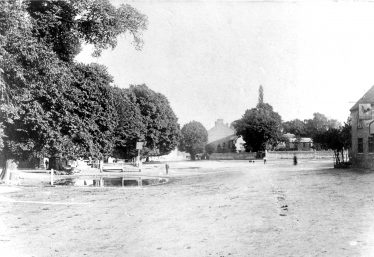
The Cock pond, with Mr Lockhart’s house behind the wall on the south side of Church Green – the north end of ‘The Island’
In the centre of the Village, then as now, was the Island site. Mr Lockhart lived in Island Cottage with his wife Mary and their five children. There were also three servants in the house. Frederick Lockhart was a coal and brick merchant. He supplied coal for the local coal club at 14/- per ton in 1870. That year he delivered 138½ tons to those who had made use of this facility in the village. The Island Cottage had stabling and gardens, and its annual rent was £45. Later Mr Lockhart left the village centre to live in Lea House, which once stood at the top of Ox Lane (now Lea Court). Many of the Sunday School Feasts were held in Mr Lockhart’s field [which ran down alongside Westfield Road].
The houses on the Island site were quite close together, and a variety of trades were carried on there. Frederick Farnell, a master butcher, and William Dudmash, a saddler were near neighbours to Thomas Simons a grocer and baker. The Simons family was quite large: there were nine children. The eldest daughter was a book-keeper in the family business; the rest of the six girls and two boys were all recorded as scholars. There was another large family close by: Edwin Archer, who was a boot and shoe-maker, had three sons and four daughters.
The White Lion was kept by William Robinson, and the next business was that of a newsagent and stationer, Levi Whitehouse. This business had begun when the small school run by Mr and Mrs Whitehouse had been closed, when their cottage was demolished to make way for the National School.
Amos Hawkins, a smith and wheelwright, and John Willis, a record clerk at the Laboratory, as Rothamsted Experimental Station [Rothamsted Research] was then known, lived on the part of the Island facing what is now Leyton Road. John Willis had been privately educated at Wheathampstead. He was good at drawing and diagrams. He made voluminous notes which pleased Dr Henry Gilbert of Rothamsted. He contributed articles to agricultural papers and was a most competent worker. John Willis acted as an enumerator in the census, and was for many years the hard-working secretary of the Harpenden Horticultural Society. He was an active worker in parish affairs, and took a special interest in the Temperance Society.
Harpenden had no shortage of boot and shoe makers, for yet another master boot-maker, John Archer, lived on the Island site. He had two men working for him, as well as his son who was a shopman. Elizabeth Irons, aged 60, is recorded as an Annuitant, and was a neighbour of Thomas Pike, a ride officer of the Inland Revenue*(see Comment below). Thomas Irons, a master cabinet maker, had two apprentices, and George Hiscott, who was a groom, complete the people living in the first [northern] section of the Island.
Around ‘The George’

West bakers, Busby’s chemists in the High Street – Anscombes in the background
In the next block lived James Busby, a Chemist and Druggist. His shop was on the site now occupied by Barclays Bank. He had been born in Oxford, and as well as dispensing medicines also drew teeth – this being part of the usual work of a chemist in those days.
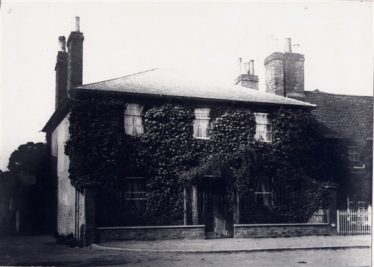
Dr Kingston’s House, High Street
Next door was Richard Batchelor, a baker and farmer of some 30 acres. Elizabeth Kingston lived where the present Kingston House [M&Co] is now. She was a benefactress to the Parish, leaving money to the Minister and Churchwardens for the provision of blankets, bread, coals and warm clothing to be provided for poor widows, widowers and fatherless girls.

The George, 1890s
The George public house was kept by William Samwells, a licensed Victualler and coachbuilder. Mr Samwells was renowned for his fine voice, and it is recorded that he was often asked to sing ‘John Barleycorn’ for the Beanfeasters when they visited Harpenden. Groups of people used to hire a conveyance for the day to visit the countryside, have a meal and a dance and a good time. Cottagers used to sell bunches of flowers to these visitors who usually came from towns.
Past Bennetts to the Silver Cup

The Silver Cup – with the next generation of the Archer family in the 1890s
The Village centre, as far as the enumerator was concerned, ended with the area of the Silver Cup. Here John Archer, bricklayer, was licensee. The cottages in the vicinity were occupied by a coal carter, a bricklayer, and among others, Tom Lovett, a rag and bone merchant. This business he combined with being Town Crier. Edwin Grey recalls him going round with his bell, announcing sales, rewards, meetings of various sorts, with the tradition ‘Oyez’, and ending with ‘God save the Queen’.
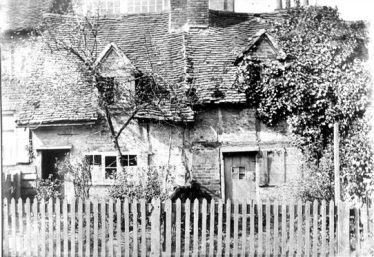
Mary Constable’s cottage, Leyton Road
The last person in this part of Harpenden was Mary Constable. She was 61 at the time of the census. Little did she guess then that she would live to see horseless carriages and many other inventions the next century brought. Dr Blake wrote of her in 1919 as the only centenarian he had known – she died in 1912 – and recorded how she told him that she had seen the Bedford Coach passing through Harpenden with convicts bound for Botany Bay, guarded by armed warders. Edwin Grey remembered her as an old lady living in a ‘picturesque but most insanitary cottage’. Even so, this ‘plaiter of straw’, as the 1871 census described her, managed to survive for 102 years despite the conditions. Perhaps the good air of Harpenden so often alluded to counteracted the conditions in which she had spent her days.
*A Ride Officer see Comments

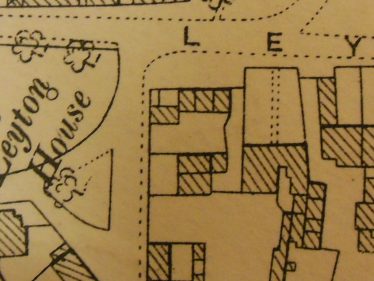

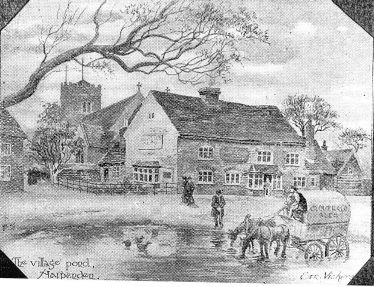
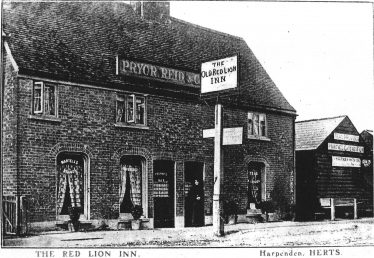
Comments about this page
According to HALS (Hertfordshire Archives and Local Studies) ’A Ride Officer or Riding Officer for the Inland Revenue was a mounted officer responsible for patrolling the coastline, within their predefined riding range, looking for ships ‘hovering’ offshore, or small boats bringing in contraband. They were not inland officers as the nature of the job required the visiting of the coast.’ This is more or less what Wikipedia says.
Thomas Pike was 28 according to the 1871 census and had been born in Tweedmouth; his wife was 27 and born Berwick on Tweed so had he been a Ride Officer back home?
In 1861 he was at home with his parents and a blacksmith; in 1881 he was in Campbeltown, Argyll and an Excise Officer so what was he doing as a householder (not a visitor or lodger) in Harpenden in 1871? Intriguing.
Add a comment about this page